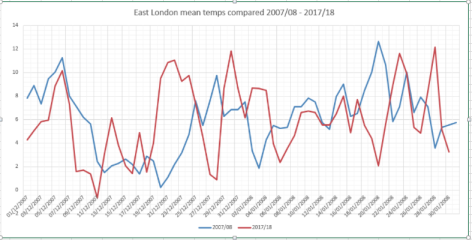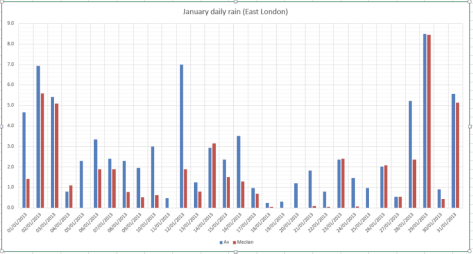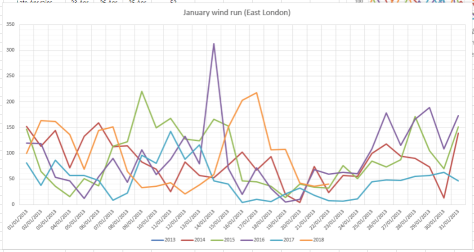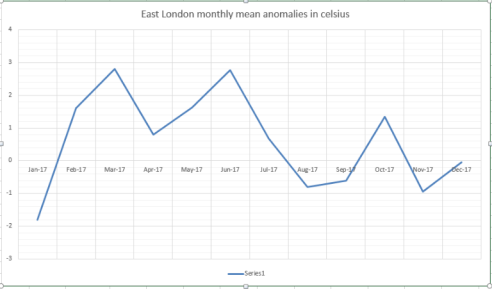This weekend marks the start of a cold spell that brought widespread wintry conditions across Britain.
Entries in Luke Howard’s Climate of London detail several instances of the wintry weather reported nationwide .
.
In London the freeze lasted 10 days, briefly losing its grip on the 19th, before returning in the final week. At its lowest on the night of the 14th the temperature fell to 10F (-12C). Despite the intense cold their was little precipitation in this area. However, across the country came reports of deep snow and hardship for shipping.
Gale force easterly winds were reported in Plymouth, Falmouth, Liverpool and Portsmouth on January 7th and 8th. On January 9th a ‘hard ENE’ly gale’ was reported at Deal, Kent.
A report reads: “It has continued blowing strong from the eastward all this day. On Thursday morning between one and two o’clock as a person was passing through Paternoster Row he observed the watchman on that beat in a state of complete paralysis and insensibility occasioned by the frost.
“He had him immediately removed to the watch house of Farringdon, within where he had not long arrived when a fellow sufferer was brought in by two of the patrol who found him in his box in Stationers Court, Ludgate Hill, absolutely frozen and unable to articulate a syllable.
“Both were immediately placed near the fire the influence of which combined with the administration of warm cordials shortly restored their suspended faculties. The thermometer at the Royal Exchange yesterday at 12 o’clock stood at 28F.”
An entry on January 14th, nearly a week into the freeze, reported a Thames “choked up with ice”.
“The river is so completely choked up with ice that the fishing boats with fish dare not come higher up than Limehouse. Putney Bridge arches are choked up with ice formed by the ebbing and flowing of the tide to a great height. At one o’clock yesterday afternoon (16th) the fog in the city was as dense as we ever recollect to have known it.
“Lamps and candles were lighted in all the shops and offices and the carriages in the streets dared not exceed a foot pace. At the same time five miles from town the atmosphere was clear and unclouded with a brilliant sun.
“Fahrenheit’s thermometer stood at 14F at 8 o’clock in the morning.
Around Britain
Newcastle: on Sunday morning last a severe frost set in here and has continued since. A considerable quantity of snow has fallen during the week.
Sunderland: the river Wear has been frozen over for the last four days down to Hilton Ferry within four miles of this town. The navigation above that place is entirely suspended.
Carlisle: a smart frost set in here on Monday morning and has continued gradually increasing up to this day Friday in severity. The river Eden is more than half frozen over near the bridge and many persons are diverting themselves on its surface. On Tuesday we had a partial fall of snow which still continues.
Westmorland: on Stainmore the weather has been more severe during the last week than it has been known for four years past. The frost is not only more than usually intense but the snow lies in fearful drifts and the wind on Friday and Saturday blew a perfect hurricane rendering it extremely difficult if not dangerous to travel.
Chester: the frost during the last week has been intensely severe and the wind is gentle and blowing almost constantly from the eastward. The thermometer on Saturday morning stood at 17F or 15F below the freezing point.
Manchester: on Friday last the temperature in the city was as low as 16F and this in the very centre of the town where the crowded buildings and immense fires kept in the manufactories must have had some effect on the atmosphere. On the 18th of January 1814 the extreme temperature was 22 below the freezing point. On the 21st of February 1810 it was the same.
Liverpool: the weather during the last week has been intensely cold, the thermometer for the last few days having been lower than during the past five years. A self registering thermometer denoted the extreme of cold on Saturday night to have been 19F and yesterday, Sunday morning at half past seven, it stood at 20F. It is very probable the present weather may continue several days as it commenced with the new moon.
Bridgewater: our river is so completely frozen over as to impede the navigation fortunately there is a good supply of coals in the town.
Canterbury: On January 17th the river Medway is frozen over and the navigation is stopped. The merchants have advanced the price of coals six shillings a chaldron.
The Royal Military Canal being now completely frozen over numerous parties are daily skating thereon. It is not unusual to take a breakfast at Hythe, a luncheon at Rye (about 20 miles glide) and return to Hythe to dinner.
On the continent
Elsineur: the sound is full of ice and the navigation suspended. (January 14th ).
Hamburg: the frost is very intense and every appearance of its continuance. Extract from a private letter dated ‘Cadiz Jan 24’: ‘We have had terrible gales at this place so violent that upwards of two hundred and fifty vessels were driven on shore.
Rotterdam: We have had frost again from the 25th but very moderate and the ice has but little increased. The wind prevails from the eastward and there is no appearance of a thaw.
Antwerp: the river continues full of drift ice. An easterly wind took place on the 25th January. The ice decreases very fast (31st) and if the thaw continues for which there is every appearance the river will be navigable in two days.
The mean temperature for the month finished 0.7C, the 14th coldest January in London back to 1797. Just 5.1mm of precipitation was recorded, the second driest January in the series. 































 .
.












You must be logged in to post a comment.